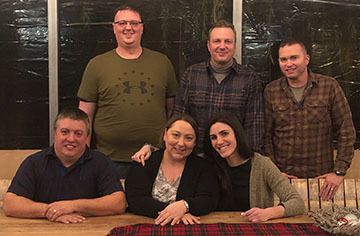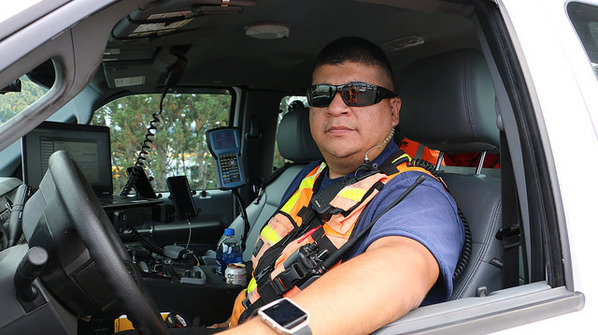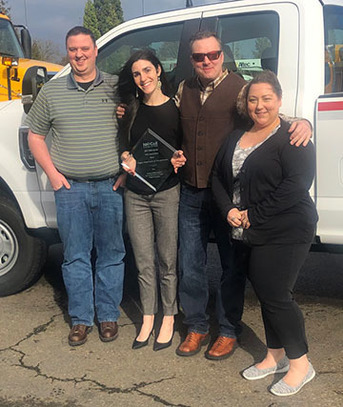
Happy New Year!
Hopefully you all had a great holiday. This is the time of year we get to see the smiles of kids, grandkids and all the people we love. We get to have good meals, celebrate family traditions and in my case create new ones with my one-year-old boy.
We are also happy to share our first newsletter of 2019! This year will be our best year—we already have several trainings scheduled across the state with no plans to slow down any time soon.
With a new year comes an opportunity to set new goals. What’s our new number to hit for responders trained? Have you trained your own agency, and if you have is it time for a refresher? Can we reach that agency that has been a challenge to get a training scheduled? These are all things we should continue to ask ourselves and reassess.
As I sat at my computer putting together my work plan for 2019 I realized something…as a team this past year we accomplished a lot. We reached a goal of 20% trained, and we refined our trainings to provide even more value to our partners. With that said, we continue to raise the bar. Federal Highway has put a 45% goal for 2019. Can we reach that?!
We are also looking to refresh our annual conference with a new format and location. And while we transition to new leadership, in the end it’s still the same team working on the same principles and goals: Safe, quick clearance!
|
 Justin Guinan, Oregon TIM Program
 Sergio Mendoza, Southern Oregon's Prolific TIM Trainer
When you attend a TIM training, you often have a few trainers from different disciplines in attendance. Odds are, one of those trainers you’ve had is Sergio Mendoza. Last year alone, he conducted over 34 TIM Trainings. That’s nearly one a week! For someone who works a full schedule at ODOT, has a family and is a contributing member of his community, the extra time it takes to conduct a 4 hour class once a week illustrates how important Sergio feels the program is to his daily life.
So this month, our spotlight is on Sergio, because everyone should know how amazing he is.
Q: How long have you worked for ODOT?
Sergio: I’ve worked for ODOT for 10 years. Dispatching at station 3 for 5 years and now doing incident response for 5 years.
Q: What do you love about your job?
Sergio: I love that every day is different. You never know what you’re going to see. It also has a lot of activities that aren’t seen by the general public or our own staff. Things like delivering training to our staff, training with other responders, helping develop new statewide training curriculum like push pull drag, and other programs, and other opportunities that pop up. There’s rarely a slow day.
Q: What are some of the ways you partner with other responders to keep the traveling public safe?
Sergio: The biggest way we help keep the traveling public safe is by training together and coordinating on scene to open our roads faster. This not only minimizes our exposure to motorists and the dangers of working in traffic, but also helps eliminate traffic queues which reduces the risk of secondary crashes that other motorists may experience.
Q: In your experience, what is critical to clearing an incident safely and quickly?
Sergio: Practice is what helps us clear that scene quickly and safely. To use a sports analogy, the more we can practice in a controlled environment and meet with each other off the field to learn and understand our roles, the better we can execute our plans on game day. If we don’t practice before we get on scene then we’ll have a steep learning curve to overcome because we’re doing it in real time with real dangers.
Q: What are some of the ways we can strengthen the communication, coordination and collaboration between response partners?
Sergio: Attending outside agency meetings, inviting others to attend our safety meetings and trainings, or just introducing ourselves and not being afraid to be our own salesperson on a scene are some ways we’ve been able to get face to face time with our partners. We let them know that our role on a scene is to help provide safety through appropriate traffic control. We then work on coordinating our schedules to get some training together where we can learn from each other and then continue that cycle so that we can keep strengthening our relationships and abilities.
Q: Tell us about a Traffic Incident Management best practice you find particularly effective.
Sergio: “How can we help?” Whether it’s someone we’ve worked with regularly or an agency or individual that we are new to, I find showing up to offer help instead of showing up to dictate what our needs are is the best way to work together.
Q: How is your agency investing in Traffic Incident Management? What benefits are you seeing?
Sergio: We hold quarterly Regional TIM meetings, schedule TIM trainings, attend after-action-reviews, and listen when our partners voice concerns or ideas at those meetings. We’ve identified hot spots in our areas and prepositioned supplies near those locations for all partners to use, we’ve seen our clearance times decrease, our relationships strengthened, and an eagerness from our partners to engage in the cross training we’re all able to take advantage of.
Q: What is your favorite thing to do outside of work?
Sergio: Camping, shooting & photography.
Q: What is your favorite _____ and why?:
Sergio:
Sports team: America’s Team – the Dallas Cowboys
Dessert: Cheesecake
Time of year: Spring or Fall – My hobbies are more enjoyable in these seasons

National Operations Center of Excellence TSMO Award
Some of you may have seen…we won an award and in no small part because of all of you!
The National Operations Center of Excellence recently announced the winners of their inaugural TSMO Awards for outstanding projects and initiatives. We won the Public Communications category.
Our program communications continues to excel because of our partners—a huge thank you to all those who participate in our responder and public safety campaigns on and off Facebook. Because of your collaboration and voices, we have been able to launch Oregon TIM Program communications into the national spotlight and share our challenges, successes and lessons learned with other states.
This award belongs to all of us. Every time we train a class, share a post on Facebook or forward this newsletter to someone, we grow our TIM Team. In growing, we can truly make a difference in the safety of our family of responders.
Check out our case study @OregonTIMResponders: Use of Social Media to engage responders and promote safety laws and practices!
Check out winners from other categories on NOCoE's website.
|
New Year, New Performance Measures
TIM performance measures enable us to identify trends, prioritize program activities, set realistic goals and track performance.
Check out our performance in 2018!
|